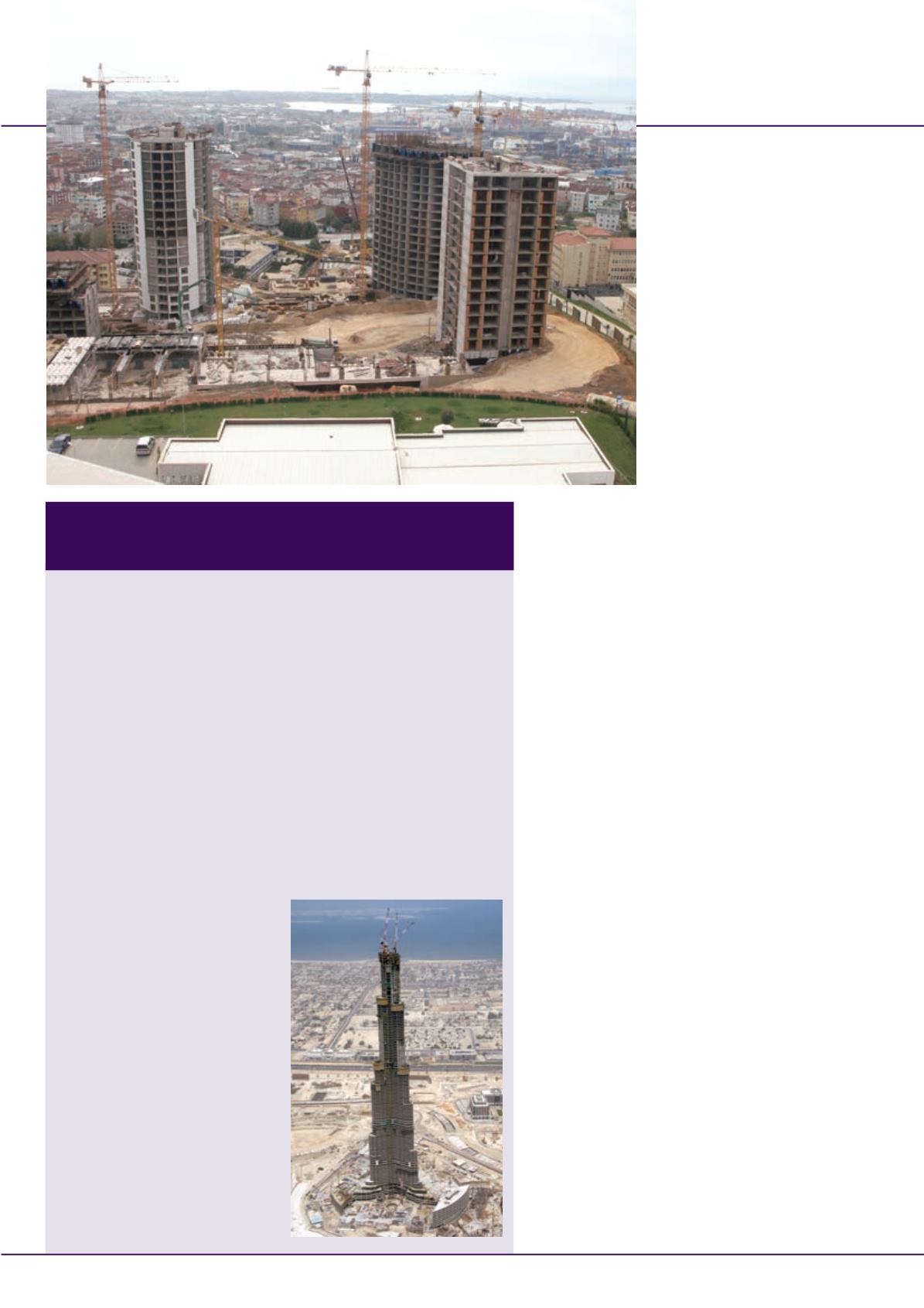
39
september 2014
international
construction
HIGHRISE
Topping out
>
shapedstoreyslabs.Peri isusing itsflexible
rail climbing system (RCS).Horizontally
cantilevered RCS climbing rails have
been used which make accommodating
the varying length of cantilevers possible.
For the formwork for the core walls,
Peri engineers combined the ACS self-
climbing formwork with a platform and
gallows.
The climbing formwork as well as the
climbing protection panel move from
floor tofloorwithout theneedof a crane.
Instead, the ACS selfclimbing formwork
uses a climbing device with 100 kN
lifting power while the RCS climbing
protection panel is lifted upwards by
means ofmobile climbing devices.
Access all areas
Site access is another area of challenge for high-rise contractors,
with passenger andmaterial hoists playing an important role in
development.
One of the longest-running high-rise builds of modern times,
the Sagrada Familia cathedral in Barcelona, Spain, is using
several passenger andmaterial hoists from SaltecTorgar.
The company has supplied four single cabin and one
twin cabin, 1,500 kg capacity,T1 passenger andmaterial hoists
to the construction site.
Buildingof the SagradaFamília started in1882, with architect
Antoni Gaudi getting involved in the project in 1883. The
cathedral currently has a completion date of 2026 – to mark
the 100-anniversary of Gaudi’s death. It will have a final spire
height of 170m.
In Turkey, contractor Sera Yapi Construction is using four
Alimak hoists for materials and personnel lifting at Emaar
Square, one of Turkey’s largest private developments. The new
development will include seven high-rise towers.
The four Alimak hoists are all Scando 450 units, designed
for materials and personnel, and can lift a maximum load
of 2 tonnes to a height of 150 m. The hoists are working in
conjunctionwith14 tower cranes to supply all the liftingneeds.
“We have fixed all four Alimak hoists to the side of the
excavation, where the entrance is located.The prime use for the
hoists is personnel transportation, as the cranes are handling
most of the material lifting,” explained Mrs Aydin, project
coordinator for Sepi Yapi.
“When the foundation work is complete we shall redeploy
the hoists to the exterior of four of themedium-rise structures,
where they will be used for both personnel andmaterials,” she
added.
Emaar Square will be completed over several phases between
2015 and 2017.
Also inTurkey, 11Liebherr cranes arebeing employed tobuild
Istanbul’s largest housing project, Evora Istanbul.
The Liebherr cranes are a combination of 8 tonne capacity
high-top 132 EC-H 8 Litronic units, 6 tonne 154 EC-H 6
Litronics, a 90 LDwith a capacity of 3 tonnes, and a 42 KR.1
crawler crane with a maximum lift of 4 tonnes and maximum
hook height of 28m.
Leap forward
How high-rise technology changewith the Burj Khalifa
B
urj Khalifa, developed by Dubai-based Emaar Properties PJSC, is theworld’s
tallest building at 828m. The project brokemany records, and put a new spin on
construction techniques to open theway to even higher projects.
Some 45,000m
3
of concrete, weighingmore than 110,000 tonnes, was used to
construct the concrete and steel foundation, which features 192 piles buriedmore
than 50m deep. Burj Khalifa’s tower construction used 330,000m
3
of concrete and
39,000 tonnes of steel rebar. Construction took 22millionman-hours.
According to Emaar Properties, Burj Khalifa’s construction saw the introduction
of several ground-breaking technologies supported by advanced equipment and
constructionmethods.
For example, the tower cranes usedwere especiallymodified to cater for extreme
heights aswell as the hook speeds and capacities required tomeet the design aspects
of Burj Khalifa. The 3.2 tonne capacity, 100m/minute hoistswere scheduled on an
hourly basis to ensure timely delivery of workers andmaterials, aswell as the removal
of debris.
The design of the concretemixes used also involved extensive trials and testing to
ensure themix remained pumpable during its long journey up the tower, and then
achieved the high early strength required
for the three-day jump from cycle. The
concretewas pumped by the largest
concrete pumps in theworld, which could
generate 350 bar of pressure and pump
the concrete through especially large and
thick steel pipes.
As the height of the tower exceeds
the limits of conventional surveying
techniques, a special GPSmonitoring
systemwas developed to ensure
millimetre accuracy during construction.
The tower’s build achieved a number
of world records, including the highest
installation of an aluminium and glass
façade, at a height of 512m. The total
weight of aluminium used on Burj Khalifa
is equivalent to that of five A380 aircraft
and the total length of stainless steel bull
nose fins is 293 times the height of the
Eiffel Tower in Paris.
Main contractor Teknik Yapı
Construction is using 11 Liebherr tower
cranes to build the high-rise elements
of Evora Istanbul.


